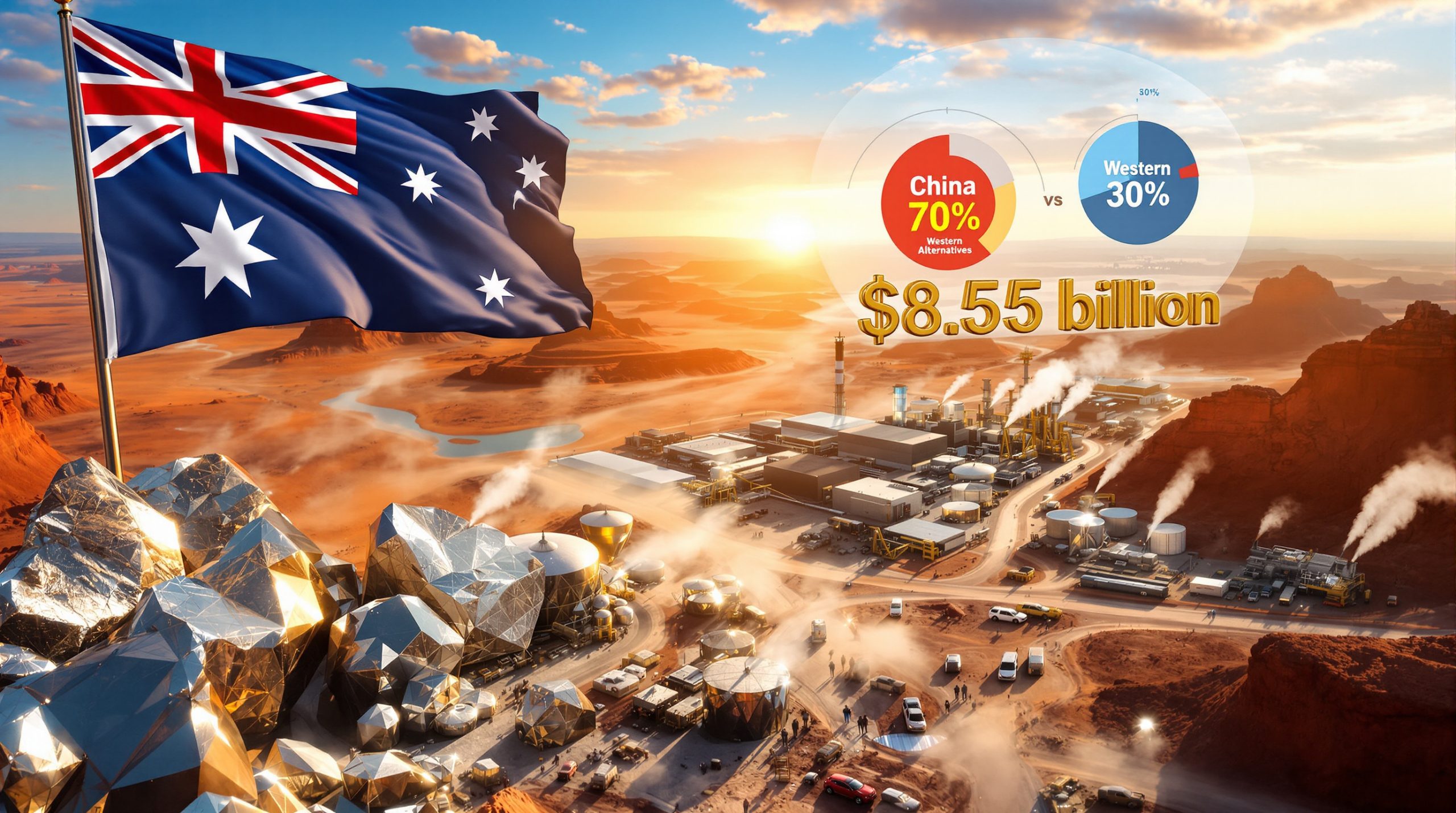Why Did Trump Order an Investigation into Imported Critical Minerals?
National Security Risk: Dependence on Imported Critical Minerals
The United States faces a significant vulnerability in its heavy reliance on foreign nations for critical minerals, particularly rare earth elements (REEs). This dependency has reached concerning levels, with the U.S. importing approximately 80% of its rare earth elements from China alone, costing around $230 million annually on these essential resources.
Statistics paint a stark picture: China controls 90% of global processed REE production, creating a dangerous supply chain bottleneck for the United States. The Department of Defense estimates that by 2030, approximately 750,000 tons of rare earths will be needed for critical defense systems – a requirement the U.S. cannot currently meet domestically.
China’s dominance in this sector is particularly alarming, as it has demonstrated willingness to leverage this advantage. According to recent government reports, the U.S. now depends on imports for more than 75% of its requirements across 31 of the 35 minerals deemed critical to economic and national security.
“US President Donald Trump signed an executive order launching an investigation into the national security risks of the country’s reliance on imported processed critical minerals,” reported Reuters on April 15, 2025, signaling official recognition of this strategic vulnerability.
China’s Retaliatory Export Restrictions: What’s at Stake?
In a concerning development, “China placed rare earth elements under export restrictions in retaliation to Trump’s steep tariffs,” according to Reuters in April 2025. This move mirrors China’s 2010 strategy when it leveraged REEs during previous trade disputes, resulting in global supply disruptions that lasted six months.
Rare earth elements, despite their name, are relatively abundant in the Earth’s crust but rarely found in concentrated, economically viable deposits. What makes them invaluable is their unique properties essential for high-tech applications. These 17 elements are crucial components in everything from smartphones and electric vehicles to precision-guided missiles and radar systems.
The economic impact of China’s REE export restrictions has been immediate and severe. Post-restriction prices have surged dramatically, with neodymium increasing by 40% and dysprosium by 60%. China’s REE export quotas have dropped to 35,000 tons in 2025 from 50,000 tons the previous year, further tightening global supply.
| Rare Earth Element | Primary Application | Price Increase After Restrictions |
|---|---|---|
| Neodymium | Magnets for electric vehicles, turbines | +40% |
| Dysprosium | High-performance magnets, lasers | +60% |
| Lanthanum | Battery technology | +35% |
| Terbium | Phosphors, solid-state devices | +45% |
The U.S. Trade Representative has estimated that these export controls could cost American technology firms $3.2 billion in 2025 alone, with companies like Apple already reporting production delays due to magnet shortages.
What Does Trump’s Executive Order Entail?
Key Provisions of the Executive Order
Trump’s executive order represents a comprehensive approach to addressing America’s critical mineral vulnerability. The directive allocates $2 billion under the Defense Production Act specifically for accelerating mine permitting processes that have historically hindered domestic production.
The order mandates a thorough investigation into 14 specific critical minerals, including cobalt, graphite, and various rare earth elements. This investigation will assess current supply chains, identify vulnerabilities, and develop strategies to secure reliable supplies of these materials essential for advanced technologies and defense systems.
“The executive order calls for a thorough investigation to identify risks, potential disruptions, and strategies to enhance domestic self-reliance.” (White House Official Statement, April 2025)
A significant innovation in the order is its invocation of Section 303 of the Defense Production Act, which creates pathways to bypass certain National Environmental Policy Act (NEPA) requirements for projects deemed strategically essential. This approach mirrors Australia’s critical minerals boost through its Critical Minerals Facilitation Office, which has successfully reduced mine approval timelines to just 18 months.
Unlike previous initiatives that focused solely on extraction, this order explicitly prioritizes onshoring refining and processing capabilities – the technical bottleneck where China has established dominance. The order creates a framework for rapid identification of domestic resources coupled with accelerated development of processing infrastructure.
Timeline and Expected Outcomes from the Investigation
The executive order establishes a clear timeline with specific milestones for the investigation:
- Phase 1 (0-60 days): Department of Energy audit of existing REE stockpiles, currently estimated at only 45 days of supply
- Phase 2 (60-120 days): U.S. Geological Survey identification of 3-5 high-priority mining sites for expedited development
- Phase 3 (120-180 days): Interagency development of financial incentives for domestic processing facilities
- Phase 4 (180-240 days): Presentation of comprehensive strategy to achieve 50% domestic processing capacity by 2028
The expected deliverables from this investigation include:
- Comprehensive vulnerability assessment of each critical mineral supply chain
- Identification of strategic reserves necessary to mitigate short-term disruptions
- Streamlined permitting frameworks for high-priority mineral projects
- Tax incentive proposals to offset the 20-30% cost disadvantage domestic producers face compared to Chinese competitors
- Public-private partnership models for financing capital-intensive processing facilities
Why is the US Reliant on Imported Critical Minerals?
Overview of Domestic Production Capacity and Constraints
The United States possesses significant geological reserves of critical minerals but faces substantial challenges in extraction and processing. U.S. mining contributes just 0.9% to GDP compared to 6.5% in Australia, reflecting decades of underinvestment and regulatory constraints.
Current domestic production meets only 15% of defense-critical mineral demand according to a 2025 Senate Energy Committee Report. Mountain Pass Mine in California, the nation’s largest rare earth operation, produces approximately 15,000 tons of unprocessed REEs annually but still relies on Chinese facilities for separation and refining.
“America’s dependence on China for critical mineral processing capacity remains unsustainable,” reiterated by USA Rare Earth CEO in a Mining.com video interview from April 2025. “China’s monopoly on processing infrastructure makes the U.S. vulnerable to geopolitical coercion.”
The technical challenges are equally significant. Rare earth refining requires specialized techniques like solvent extraction, a process China has optimized over decades. Building domestic expertise and infrastructure will require significant investment and time.
Examining Historical Factors of Dependence
America’s current mineral dependency stems from multi-decade policy decisions. Throughout the 1980s and 1990s, environmental regulations increased while mining investment incentives decreased, creating a perfect storm for offshoring mineral production.
The Clean Air Act and subsequent amendments added approximately $1.3 million in compliance costs per mine annually, according to industry assessments. While these regulations brought important environmental protections, they were implemented without parallel support for cleaner mining technologies.
A former EPA Administrator noted, “NEPA lawsuits have blocked 12 major mines since 2020 alone,” highlighting how environmental litigation has become a significant barrier to resource development. The Twin Metals Mine cancellation in 2023 over Boundary Waters concerns exemplifies how even advanced projects can be halted after years of investment.
Complicating matters further are regulations surrounding thorium, a mildly radioactive element that often occurs alongside rare earth deposits. Under the Atomic Energy Act, thorium is classified as a nuclear material requiring special handling, significantly increasing extraction costs for many REE deposits.
Implications of Trade Tariffs and Export Restrictions
The 2025 tariffs raised Chinese REE costs by 25%, but domestic prices remain approximately 30% higher due to higher labor, regulatory, and capital costs. This price differential creates a challenging environment for establishing competitive domestic production.
The Center for Strategic and International Studies (CSIS) has warned that “a 6-month REE shortage could idle 80% of U.S. wind turbine plants,” demonstrating the renewable energy sector’s vulnerability to supply disruptions. Similarly, defense contractors like Lockheed Martin reported a 9% profit decline in Q1 2025 due to supply chain disruptions.
The technical challenges of substituting critical minerals further compound these issues. Dysprosium’s magnetic stability properties, for example, are essentially irreplaceable in electric vehicle motors, making demand relatively inelastic regardless of price increases.
How Do Export Restrictions Impact Critical Industries?
The Role of Rare Earth Elements in Strategic Industries
Critical minerals, particularly rare earth elements, form the foundation of numerous strategic industries vital to both economic prosperity and national security:
- Renewable Energy: Each megawatt of wind power requires approximately 600 kg of rare earth elements. The Biden administration’s goal of 30 gigawatts of offshore wind by 2030 would require 18,000 tons of REEs.
- Electronics and Semiconductors: Modern smartphones contain 16 of the 17 rare earth elements. The semiconductor industry relies heavily on cerium for polishing wafers and gadolinium for memory storage applications.
- Defense Technologies: An F-35 fighter jet contains approximately 920 pounds of rare earth materials. Missile guidance systems, radar installations, and night vision equipment all depend on REEs for their functionality.
- Electric Vehicle Manufacturing: Each EV requires 1-2 kg of neodymium for its motor magnets. Tesla’s $1.6 billion investment in Brazilian NdFeB mines demonstrates how companies are scrambling to secure supplies outside Chinese control.
The interconnected nature of these industries means that restrictions on critical minerals have cascading effects throughout the economy. When China reduced export quotas to 35,000 tons in 2025, it created bottlenecks affecting multiple sectors simultaneously.
Economic Impact Analysis of Export Restrictions
The economic consequences of China’s export restrictions have been severe and widespread. Industry analysts project that extended restrictions could increase consumer electronics prices by 8-12% by year-end as manufacturers absorb higher component costs.
The price volatility has been particularly dramatic for key elements:
| Rare Earth Element | Price Before Restrictions | Price After Restrictions | Percentage Increase |
|---|---|---|---|
| Neodymium | $87/kg | $122/kg | +40% |
| Dysprosium | $352/kg | $563/kg | +60% |
| Terbium | $940/kg | $1,363/kg | +45% |
| Praseodymium | $75/kg | $102/kg | +36% |
These price increases directly impact manufacturing costs and investment decisions across multiple industries. Apple’s Q2 2025 earnings call cited a 12% production delay in their newest devices specifically due to magnet shortages, demonstrating how even the largest technology companies remain vulnerable.
Can Domestic Critical Mineral Production Alleviate This Dependency?
Potential for Growth in Domestic Mining and Processing
The United States possesses significant geological potential for reducing import dependence. The Mountain Pass Mine in California, currently the nation’s largest rare earth operation, is expanding with a $700 million Department of Energy grant to build an on-site separation facility, eliminating the need to ship concentrates to China for processing.
The Texas Rare Earth Resources Project represents another promising development, with plans to produce 7,000 tons of rare earths annually by 2027. This project employs innovative in-situ leaching techniques that reduce environmental impact by approximately 40% compared to traditional open-pit mining.
“Investing heavily in domestic mining capabilities reduces strategic vulnerabilities and bolsters economic security,” stated Fortune Minerals CEO in a Mining.com interview from April 2025. The company has emphasized that “tax incentives must offset China’s 20% lower labor costs” to make domestic production competitive.
Recycling technologies are also advancing rapidly. The Pentagon’s $120 million grant to Urban Mining Co. for magnet recycling demonstrates how recovering materials from electronic waste could supplement primary production. Current estimates suggest recycling could potentially satisfy 15-20% of U.S. rare earth needs by 2030.
Key Challenges for Increasing Domestic Production
Despite promising developments, significant obstacles remain for expanding domestic production:
- Permitting Delays: The Brookings Institution reports that permitting delays average 7-10 years for U.S. mines compared to 1-3 years in Australia and Canada.
- Environmental Opposition: High-profile projects like the Bear Lodge Project in Wyoming have faced extensive challenges related to water rights and wildlife protection.
- Processing Expertise: China’s decades-long dominance has created a knowledge gap in rare earth processing technology and skilled personnel.
- Capital Requirements: Establishing a complete mine-to-magnet supply chain requires approximately $1.5 billion in initial investment per facility.
- Market Uncertainty: Concerns about China potentially flooding markets to undercut emerging competitors create investment hesitancy.
Industry experts propose solutions including regulatory reform, public-private risk-sharing arrangements, and dedicated training programs to rebuild domestic technical expertise in mineral processing.
How has Similar Policy Worked in Other Countries?
Australia provides a compelling case study in critical mineral strategy development. Key elements of Australia’s success include:
- Creation of the Critical Minerals Facilitation Office to streamline permitting
- Establishment of a $4 billion Critical Minerals Export Credit Agency to support project financing
- Strategic partnerships with Japan and South Korea to secure off-take agreements
- Integration of mining operations with downstream processing through targeted incentives
- Investment in research institutions focused on developing cleaner extraction technologies
The results speak for themselves: Australia now supplies approximately 50% of non-Chinese rare earths to global markets and has reduced approval timelines for strategic mines from 5+ years to 18 months.
Major Resource Players in Australia’s ASX Top 200 and their Role
Role of BHP, Rio Tinto, Mineral Resources (MIN), and South32 (S32)
Australia’s major mining companies have pivoted strategically to capitalize on growing demand for critical mineral shortages, with each taking distinctive approaches:
BHP has committed $1.2 billion to the Hastings Technology Metals joint venture, focusing on developing heavy rare earth deposits in Western Australia. This strategic diversification from their traditional iron ore and copper operations represents a significant shift toward future-facing commodities.
Rio Tinto’s approach emphasizes technological innovation, with their Automated Haulage System cutting Pilbara mine operating costs by 15%. Their $500 million investment in the Jadar lithium project in Serbia further demonstrates their commitment to battery metals crucial for the energy transition.
| Company | Recent Critical Minerals Initiative | Investment | Location | Target Minerals |
|---|---|---|---|---|
| BHP | Hastings JV | $1.2B | Western Australia | Heavy REEs |
| Rio Tinto | Jadar Project | $500M | Serbia | Lithium, Borates |
| Mineral Resources | Mt Marion Expansion | $350M | Western Australia | Lithium, Tantalum |
| South32 | Hermosa Project | $1.7B | Arizona, USA | Zinc, Lead, Silver |
| Lynas | Kalgoorlie Processing | $500M | Western Australia | Light REEs |
South32’s Hermosa Project in Arizona represents a major step forward in strengthening U.S. mineral security, highlighting the company’s strategic investment in domestically sourced critical minerals.
Mineral Resources (MIN) has distinguished itself through technological innovation, with their Mount Marion mine implementing AI-driven ore sorting to achieve 92% purity for lithium concentrates. This emphasis on processing technology mirrors the approach needed in the U.S. context.
Frequently Asked Questions (FAQs)
What are Critical Minerals and Why are They Important?
Critical minerals are raw materials essential for economic prosperity and national security that face supply chain risks. They include rare earth elements, lithium, cobalt, graphite, titanium, and others crucial for high-tech manufacturing, renewable energy, and defense applications. Their importance stems from their irreplaceable properties in technologies ranging from smartphones to military systems, combined with concentrated supply chains vulnerable to disruption.
How Much Does the US Depend on Imported Rare Earth Elements?
The United States imports approximately 80% of its rare earth elements, with China supplying the vast majority. According to 2025 import statistics from the U.S. International Trade Commission, American companies spent $230 million annually on these imports. Domestic production currently meets only 15% of defense-critical mineral demand, with the remainder coming from foreign sources. This dependency extends across 31 of the 35 minerals deemed critical to economic and national security.
What Actions has China Taken Regarding Rare Earth Exports Recently?
In April 2025, China implemented export restrictions on rare earth elements in direct retaliation to Trump’s tariff policies. These restrictions included reducing export quotas to 35,000 tons (down from 50,000 tons in 2024),
Interested in Spotting the Next Major Mineral Discovery?
Discover how to identify significant ASX mining opportunities before they explode in value with Discovery Alert’s proprietary Discovery IQ model. Visit our discoveries page to explore how historic mineral finds have generated substantial returns and start your 30-day free trial today.




